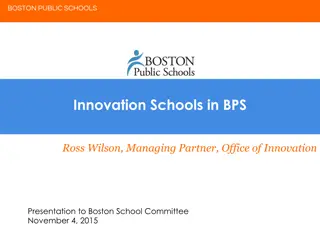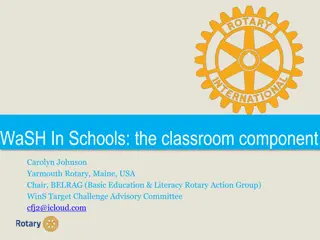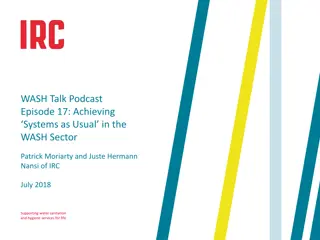Importance of WASH in Schools: Enhancing Health and Education
Ethiopian school WASH initiatives aim to improve access to water, sanitation, and hygiene facilities in schools. By addressing these issues, the program enhances student health, attendance, and academic performance, ultimately contributing to a healthy and productive generation. The Ministry of Education has led efforts to prioritize school WASH, highlighting the importance of creating a safe and clean learning environment for all children.
Download Presentation

Please find below an Image/Link to download the presentation.
The content on the website is provided AS IS for your information and personal use only. It may not be sold, licensed, or shared on other websites without obtaining consent from the author.If you encounter any issues during the download, it is possible that the publisher has removed the file from their server.
You are allowed to download the files provided on this website for personal or commercial use, subject to the condition that they are used lawfully. All files are the property of their respective owners.
The content on the website is provided AS IS for your information and personal use only. It may not be sold, licensed, or shared on other websites without obtaining consent from the author.
E N D
Presentation Transcript
Description: https://encrypted-tbn3.gstatic.com/images?q=tbn:ANd9GcQcxfHQCjcGIg4l7qYeBJf5jsdlbTfhy3--lfwAk4QutqqYaPWfiWx-Jpo School WASH Overview Yohannes Wogasso School Improvement Program Directorate June 18, 2019 Addis Ababa 1
PRESENTATION OUTLINE The Importance of SWASH Background School WaSH in ESDP V (GTP II) Status of WASH in Schools (WinS) WASH in Schools (WinS) Main Achievements School WASH Major Challenges 2
Why WaSH in Schools (WinS) is important? 3
WHY IS WASH IN SCHOOLS IMPORTANT? Every child around the world deserves an opportunity to learn in a safe and healthy/clean environment. Reduce student absence Visible increase in student s enrollment and reduction in drop-out rates. Improve (increase) nutritional status or (decrease malnutrition rate) Students perform better Invests in life-long positive skills Reduce soil-transmitted helminthic infection, diarrheal diseases and acute respiratory infection Reduce child mortality and develop healthy and productive generation. Address issues of gender and socio-economic equity 4
WASH IN SCHOOL BOOSTS ATTENDANCE AND ACHIEVEMENT Improved WaSH Economic growth Increased performance Less disease Increase attendance 5
BACKGROUND Ethiopian school WASH has been a sector agenda since recent years, and the country has moved forward in terms of creating understanding among key stakeholders on the health risks associated with lack of access to WASH and influencing sector actors to walk the talk. The 2012 National WASH Inventory was the eye opener as it has put light on the level of schools access to improved water supply and sanitation. Results of the inventory showed that only 32% of the schools had access to improved water supply, and only 34% of the schools had access to improved toilet facilities whereas the majority of the schools have traditional pit In 2012, consensus was reached among key stakeholders on the importance of giving more attention to school WASH, where education sector has taken up the leadership role. The Ministry of Education has received leadership on the development of WASH in Schools in accordance with the Memorandum of Understanding signed among the key WASH ministries, donors and CSO representatives in 2012.
Continue.. In 2013, Institutional WASH (school WASH; health facility WASH) was addressed as one component of the One WASH National Program Document (Program Operation Manual, 2013). Since recent years the MoE has taken the leadership roles where considerable efforts have been made to institutionalize WASH in Schools. Program management units have been established within the ministry at federal level and its line bureaus at regional levels. Nevertheless, specific mechanism for coordinating WASH in Schools with other sectors has not yet been materialized at all levels down to the woreda level because of lack of full time staffs both at zonal and woreda levels.
WaSH in ESDP V (GTP II) Education Sector A. WaSH Focus Area In 2015, the MoE began full implementation of the One WASH (WASH: Water Sanitation and Hygiene) strategy to improve school health through adequate supply of water and sanitation facilities. Providing basic WASH facilities in pre-primary settings, primary and secondary schools as per the standards agreed in line with the One WASH national strategy Developing and Distributing standard package of emergency teaching and learning materials, including WASH B. Targets Efforts will seek to ensure full access, based on accepted quality standards, to water and sanitation facilities in all educational institutions.
STATUS OF WASH IN SCHOOLS Total Number of schools in Ethiopia on 2017 38,023 40,000 34,867 35,000 Number of schools 30,000 25,000 20,000 15,000 10,000 3,156 5,000 - Primary schools Secondary schools Total Water availability in P +S schools by 2017 Types of latrines in P+S schools by 2017 All type of Latrines in P+S schools by 2017 No 5,270 (14%) No 14,569 (38%) Without 19,839 Yes 32,753 (86%) Yes 23,454 (62%) Traditional 17,507 (54%) Improved 15,246 (46%)
HAND WASH SITUATION IN 34,867 PRIMARY SCHOOLS Functionality of HWFs Schools with hand wash facilities Yes 7,909 (21 %) No 878 (11 %) Yes 7,031 (89%) No 30,114 (79 %) Availability of soap with HWF Yes 2,294 (29 %) No 5,615 (71 %)
WASH in School (WinS) Main Achievements School WASH isincorporated as cross cutting issue in ESDP V for the first time. School WASH Minimum Package indicators are adopted and incorporated in Education Management Information System (EMIS) in 2015. Evidences showed that there is paramount reduction in drop-out rates specifically girls due to creating access to girls friendly WASH facilities. Develop School WASH Manuals for pre-primary, primary and secondary schools Design and Construction Manual SWASH Management and Operation and Maintenance manuals & also Develop, the 1st ever document in education sector, National School WaSH Strategy, Guideline and different Implementation Toolkits/Training Manuals.
Continue....... School WaSH Strategy, and Guideline documentsare endorsed and distributed to all regions, WASH sector Ministries and NGOs and other relevant stakeholders. Both documents are launched in the presence of governmental , NGO and different stakeholders. Training of Trainers (ToT) is given to regional education bureau WASH specialists and relevant staffs. Cascading training is given by REB WASH Specialists to Zonal and Woreda education offic. Translation of the guideline and strategy documents are done Establishment of WaSH Program Management Unit (PMU) at Federal Ministry of Education and Regional Education Bureaus in all regions. Sector wide awareness creation on school WASH is done. Thus, WaSH program has gotten ownership in the Education Sector. One plan, One Budget and one Report system (OWNO-CWA) is declared and currently in use.
ONE WASH-CWA PROGRAM Capacity Building: Nearly 37,618 participants were trained in different topics related to implementation of School WaSH program from Regional, Zonal, Woreda and School level Water Supply: Cumulatively, 1,419 different new water schemes are constructed and rehabilitated up to this 3rd quarter. Sanitation: About 2,525 new latrines and hand washing facilities are constructed and rehabilitated up to this 3rd quarter. School Beneficiaries: With regard to the number of school beneficiaries, a total of 3,287 schools are benefited both from water supply schemes and sanitation facilities up to this 3rd quarter. Staffing (MoE): Ministry of Education has recruited 3 WaSH consultants (1 Public Health specialist, 1 water supply specialist and 1 monitoring and evaluation specialist). Staffing (Regions): With regard to regions, overall, fourteen technical specialists (7 hygiene and sanitation specialists, 6 water supply and 1 monitoring & evaluation specialists) are recruited across all regions.
STRATEGIC OBJECTIVE 1: BY 2020, ACHIEVE THE PROVISION OF SAFE AND ADEQUATE IMPROVED SCHOOL WATER SUPPLY FOR ALL Increase proportion of primary schools using drinking water from improved water sources available at the school from the baseline 38.4% to 80% Increase proportion of secondary schools using drinking water from improved water sources available at the school from the baseline 63% to 100% Increase proportion of schools that conduct bacteriological water quality test from the baseline to 50% Decrease proportion of non functionality rate of water supply system in primary schools from the baseline 19% to 5% Decrease proportion of non functionality rate of water supply system in secondary schools from the baseline 10% to 0%
STRATEGIC OBJECTIVE 2: BY 2020, ACHIEVE ACCESS TO ADEQUATE AND EQUITABLE IMPROVED SCHOOL SANITATION FOR ALL WHICH ARE SAFE, CHILD, DISABILITY AND GENDER SENSITIVE Increase proportion of primary schools with access to improved latrines from 38.6% to 80%. Increase proportion of secondary schools with access to improved latrines from 54.3% to 100%. Increase proportion of open defecation free schools from the baseline 18% to 82% Increase proportion of schools with proper waste management service (solid and hazardous, etc.) from the baseline to 80% Increase proportion of schools with proper liquid waste management service from the baseline to 80% Increase proportion of schools latrines emptied and properly disposed from the baseline to 50%.
STRATEGIC OBJECTIVE 3: BY 2020, ACHIEVE ACCESS TO HYGIENE SERVICES AND PROMOTE BASIC HYGIENE BEHAVIOR/PRACTICE. Increase proportion of schools with hand washing facilities with soap and water available from the baseline 20.8% to 80% Increase proportion of schools with menstrual hygiene management facilities with soap and water from the baseline to 100% Increase proportion of students practicing hand washing with soap/substitute at all critical times from the baseline to 85%. Increase the proportion of adolescent students practicing proper menstrual hygiene management from the baseline to 100%.
STRATEGIC OBJECTIVE 4: BY 2020, CREATE ENABLING ENVIRONMENT FOR SCHOOL WASH PROGRAM Establish school WASH structure from federal to school level. Develop school WASH implementation guidelines, design and construction and training manuals Human resource development and capacity building Strengthen monitoring and evaluation, learning and research
SCHOOL WASH MAJOR CHALLENGES Gap of understanding on the impact of WASH on education No public budget allocation specifically for School WASH program except Matching Funds No Government Institutional Structure except CWA-Project staffs in relation to school WASH program at all level. Low budget allocation/proportion to construct Full Package WASH Facilities at school level- in terms of CWA program Lack of Zonal WASH structure for CWA Program specially for big regions Late disbursement of budget from Development partners to MoF and from MoF to BoFED (CWA) High turnover of SWaSH focal persons and as well as WaSH Consultants due to benefit package Weak integration with water sector offices on the construction of school water supply schemes 19























